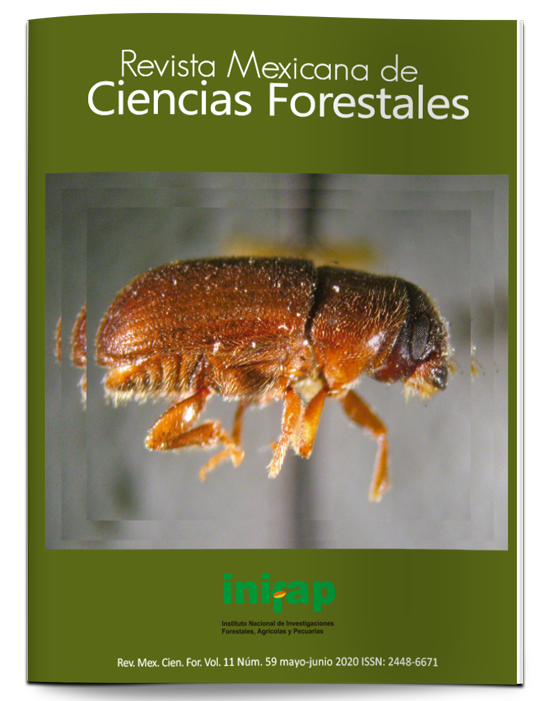Spatial structure of the mixed and uneven-aged forests in the state of Durango
DOI:
https://doi.org/10.29298/rmcf.v11i59.614Keywords:
Spatial distribution, mark correlation function, Ripley's K function, point pattern, Sierra Madre Occidental, permanent forest and soil research sitesAbstract
The purpose of this work was to describe the spatial structure and research the interactions or correlations among certain tree characteristics in the mixed and uneven-aged forests in the state of Durango. Data of individual tree location and other tree attributes of 446 permanent forest research plots were used. The spatial tree distribution and the interactions among groups of species were determined with the use of the second-order statistic known as Ripley's K function in its univariate L(r) and bivariate L12(r) normalized forms. The dimensional association between the sizes of the tree diameters was evaluated with the use of the mark correlation function Kmm(r). The results provided by these statistical tools allow to determine that the spatial structure of the evaluated forests has a complex nature and depends on the scale at which it is analyzed. At distances under 2 m, the random spatial distribution of the trees dominates, while at distances over 2 m the clustering of trees is prevalent. On the other hand in most of the studied sites no significant interactions or mixtures in the spatial distribution of trees of pine and oak were observed, indicating that regeneration and selective silviculture follow a random pattern. The analysis of the spatial interaction between the tree diameter sizes keeps an independent spatial distribution pattern, in which trees with different diameters are mixed randomly within the studied sites.
Downloads
Published
How to Cite
Issue
Section
License
The authors who publish in Revista Mexicana de Ciencias Forestales accept the following conditions:
In accordance with copyright laws, Revista Mexicana de Ciencias Forestales recognizes and respects the authors’ moral right and ownership of property rights which will be transferred to the journal for dissemination in open access.
All the texts published by Revista Mexicana de Ciencias Forestales –with no exception– are distributed under a Creative Commons License Attribution-NonCommercial 4.0 International (CC BY-NC 4.0), which allows third parties to use the publication as long as the work’s authorship and its first publication in this journal are mentioned
The author(s) can enter into independent and additional contractual agreements for the nonexclusive distribution of the version of the article published in Revista Mexicana de Ciencias Forestales (for example, include it into an institutional repository or publish it in a book) as long as it is clearly and explicitly indicated that the work was published for the first time in Revista Mexicana de Ciencias Forestales.
For all the above, the authors shall send the form of Letter-transfer of Property Rights for the first publication duly filled in and signed by the author(s). This form must be sent as a PDF file to: ciencia.forestal2@inifap.gob.mx
This work is licensed under a Creative Commons Attribution-Noncommercial 4.0 International license.







